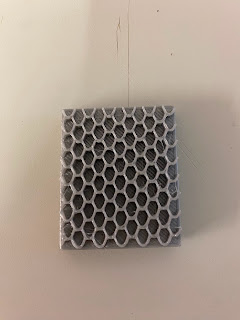Honeycomb
Honeycomb
Project Idea
After realising I wanted to focus on structure for my project, I thought about the structure that is most interesting to me, this being honeycomb. This is because although many designers and architects have been inspired by natural structures or products, nothing has been used as much as the honeycomb structure has. I believe the simplicity of honeycomb allows it to be useful in so many products ranging from aircrafts to cardboard and packing, which is remarkable for something that was originally designed and made by bees to live in and store their honey and larvae.
Honeycomb consists of hexagonal wax cells built by honey bees in the hives to contain their larvae and stores of honey and pollen. Bees are frugal with their wax, and will use the most optimal method of distribution to reduce the total material used, whilst providing the most strength.
Hexagons are the highest-sided polygons that fit together, comparing tessellated triangles and hexagons with the same area illustrates that hexagonal honeycombs minimise the material needed, making them space-efficient. In an interview with Thomas Hales, he said that a hexagonal honeycomb is the way to fit the most area with the least perimeter, from a bee's perspective this means storing ore honey in a larger volume while spending less energy building a structure to contain it.
When stacked together, hexagons fill spans in an offset arrangement with six short walls around each 'tube', giving the structures a high compression strength as well as temperature regulation. The efficiency in which honeycomb structures operate are important for man-made structures as well, so honeycomb has influenced human designs for centuries.
Man-made Structures
Honeycomb structures have the geometry found in natural honeycomb to allow the minimisation of the amount of used material to reach the minimal weight and material cost. These structures vary widely but a common feature is hollow cells (often columnar and hexagonal) formed between thin vertical walls. This structure provides a material with minimal density and relative out-of-plane high compression and shear properties. One of the earliest examples of this is seen in the interior ribbing and hidden chambers of the dome of the Pantheon in Rome.
It is widely used in the aerospace industry because the structure provides high specific strength made by layering honeycomb material between two thin layers of that provide strength in tension. Hugo Junkers first explored honeycomb structures within a laminated structure. He patented the first honeycomb cores for aircraft application in 1915 and his concept was to replace the fabric covered aircraft structures by metal sheets and he reasoned that a metal sheekcan be loaded in compression if supported at very small intervals by arranging a series of hexagonal hollow bodies.






Comments
Post a Comment